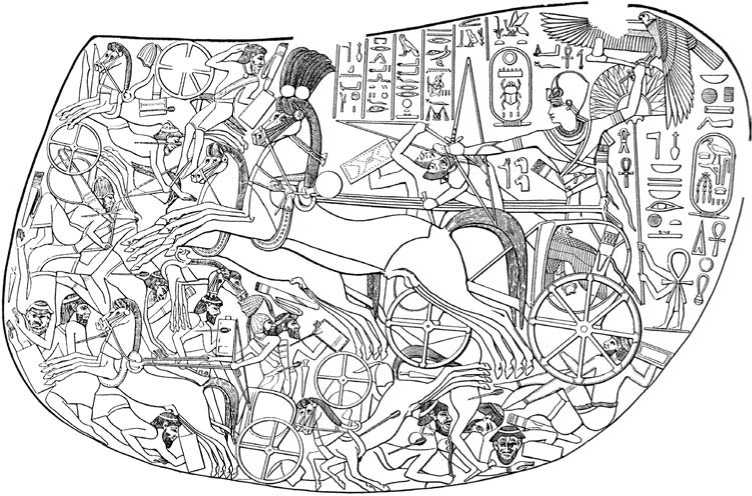Under Kamose, Ahmose, Amenhotep I, and Thutmose I consolidation and expansion proceeded under a policy of annexation of territories outside the boundaries of Egypt. Kamose continued the traditional strategy of using his war fleet to transport his

Figure 23.4 Thutmose IV in action with a war chariot and a composite bow. After Howard Carter in Carter and Newberry, Tomb of Thoutmosis IV.
Chariots, horses, archers, and infantrymen northwards (Smith and Smith 1976; Spalinger 2005: 1-5). He succeeded because he advanced quickly through Middle Egypt. In addition, he had the luck to capture an emissary of the Hyksos ruler, Apophis, who was going west through Libya on his way to contact the independent Nubian monarch. Subsequently, Kamose attacked Avaris with his Theban fleet.
Ahmose, Kamose’s successor, deployed chariots outside Avaris, and his war reliefs at Abydos indicate the growing importance of this sector within the Egyptian military (Harvey 1998: 303-72; Spalinger 2005: 19-23). Meanwhile, a governor was installed at the Second Cataract in the fortress of Buhen who acted as the king’s deputy over the Nubian territories; this position evolved into the ‘‘King’s son of Kush.’’ The increasing complexity of administrative control necessitated a garrison system that would include civilians and soldiers.
Egypt was particularly fortunate that adjoining the East Delta lay the extremely arid Sinai. To the north were small city-states that were often fighting with each other and never capable of achieving any unity. After Ahmose sacked the Hyksos capital, he advanced to the kingdom of Sharuhen in the northeast (Oren 1997a). This was the commencement of a series of campaigns, led by the kings themselves, aimed at seizing Palestine. The Asiatic wars of these Pharaohs show how changed was the structure of the Egyptian army. Egypt, already possessing a fleet, quickly developed a Mediterranean flotilla in order to transport war materiel and troops to Lebanese ports. At the same time she now relied upon infantry and chariotry in order to expand northwards on land. The first half of the Eighteenth Dynasty witnessed a series of campaigns aimed at controlling Palestine, out of which the chariotry division emerged as the

Figure 23.5 The Near East in the second millennium bc. Courtesy Robert Partridge.
Premier body of troops within the New Kingdom military (Gnirs 1996: 1-39; Spalinger 2005: 46-69; Redford 2003). The Pharaohs had to ensure that the local dynasts remained under their indirect suzerainty. This would be achieved under Thutmose III by adopting a policy of ‘‘personal captives.’’ Sons and brothers of a kinglet were brought to Egypt and lived at the court until the reigning prince either died or revolted. Because massive campaigns were lengthy, hard to organize, and costly, garrisons were established (Spalinger 2005: 130-6). Gaza soon replaced the old border post of Sile/Tjaru (al-Ayedi 2006), located at the extreme tip of the northeast Delta. Inland, Megiddo, located in the Esdraelon Plain in Palestine and, subsequently, Kumudi in Syria became strategic centers. Obstacles were easily overcome at first. Thutmose I, for example, reached the Euphrates while the inland kingdom of Mitanni was weak. The city-state system in Palestine was disorganized, and, as yet, there was no pressure from the Hittites based in Anatolia. Subsequently, however, Mitanni provoked an uprising in Palestine centered on Megiddo and gained the involvement of the king of Kadesh, located in Syria on the River Orontes.
Thutmose III achieved permanent control over Palestine after he completed his subjugation of Megiddo (Redford 2003), but it was necessary to station a moderately sized garrison there, whereas most of the other Asiatic cities had few Egyptian troops and chariots. The mighty kingdoms of the Mitannians and the Hittites, nonetheless, posed a latent threat to Egypt’s empire. Thutmose III often dispatched his sea fleet to the Lebanon in order to fortify those ports so that they could supply his land-based troops. It was necessary to coordinate naval with land-based activities in order to advance into the heartland of Syria. Eventually Kadesh was wrested from Mitanni, Aleppo conquered, and the Euphrates reached. Fighting persisted into the reign of Thutmose’s son Amenhotep II (Der Manuelian 1987: 47-56), and ultimately Palestine and Syria were divided into three parts and governors placed over these territories (Na’aman 1975; Spalinger 2005: 130-6).
The wars in Asia did not cease until Thutmose IV and Shutarna of Mitanni agreed to a peace treaty. In the south, despite revolts, Nubia was pacified, occupied, and administered as Wawat (Lower Nubia) and Kush (Upper Nubia). The southern boundary was set at the Fourth Cataract. Pharaoh nonetheless remained the Commander-in-Chief of his troops and an active campaigner. Crown prince Amenhotep II was even in charge of the royal dockyards in the north at Perunefer (either Memphis or Avaris) and was boastful of his warlike deeds. All male royal offspring had to be proficient in archery, horsemanship, chariotry, and rowing, and the ‘‘Sporting Tradition’’ became one of the hallmarks of New Kingdom royalty.




 World History
World History









